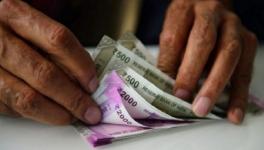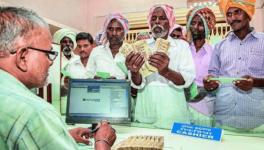Another Piece of RBI Data Showing What the RBI Doesn’t “Know”

Newsclick Image by Trina Shankar
With just four working days remaining in this month, the statutorily specified last date for the public release of the RBI’s annual report and accounts is approaching. It is expected that with this report, the RBI will have to finally declare the value of the invalidated 500 and 1000 rupee notes which were returned to it by the public and banks after the 8 November 2017 demonetization announcement. This is because it is hard to see how it can finalize its accountsfor the year ended on 30 June 2017 without ‘knowing’ this value. However, since experience suggests that the possibility of yet another incredible excuse for withholding this information cannot be ruled out, we shall have to wait and see what they will actually share with the public. However, the RBI has actually already indirectly provided some further confirmation of what almost everyone without exception believes to be the case – namely that very little if any of the invalid notes remained with the public by the end of the deadline for depositing them with banks.
The Handbook of Statistics on the Indian Economy, an annual publication of the RBI, has a Table No. 160 which provides financial year-wise figures for notes and coins in circulation by denomination. The real-time version of this on the RBI website has now been updated to include data up to 2016-17. The figures for the last two years are as shown below:
Notes and Coins in Circulation (Rupees billion)
While the figures provided by the RBI are given year-wise, they refer to the position at the end of each financial year. This can be confirmed from the fact that the sum of the aggregate value of the notes and coins for 2016-17 is Rupees 13.35 lakh crores, the same as the currency in circulation on 31 March 2017 available from the Reserve Money figures issued by the RBI. The same total for 2015-16 is also similarly equal to the Currency in Circulation on 31 March 2016.
Since no new note was issued of this denomination after 8 November 2016, the only 1000 rupee notes in circulation on 31 March 2017 would be the outlawed notes (or SBNs of 1000 rupee denomination) that had not been returned to the RBI till then. The Rs. 89.25 billion (or .089 lakh cores) worth such notes constitute just 1.3% of the value of 1000 rupee notes in circulation on 8 November 2016 (which was Rs. 6.86 lakh crores as declared long ago by the Government in reply to a Parliament Question). In other words, one can now definitively say that at least 98.7per cent of the 1000 rupee notes had been returned to the RBI by 31 March 2017.
A similar definitive statement cannot be made from this data for the 500 rupee notes because in this case a new note was issued to replace the old. The figure of 500 rupee notes in circulation on 31 March 2017 would thus include the values of invalid SBNs if any that werenot returned to the RBI as well as those of new notes issued. In principle, the former could be anything between zero and close to 100 per cent of the total. We could have known for sure even If the RBI had told us the exact value of new 500 rupee notes issued by it till 31 March 2017, a figure whose determination did not depend on the physical counting of notes returned. Unfortunately, even this information is not available. That, however, does not mean nothing can be said.
The figures of Rupees 500 notes in circulation on 31 March 2017, at Rupees 2.94 lakh crores, is about Rupees 5.64 lakh croresless than the value of 500 rupee notes in circulation on 8 November 2016 (Rupees 8.58 lakh crores). This means that at the very least 5.64 lakh crores worth of invalid 500 rupee notes were returned– and therefore the only possible range for that value would be between 66 to 100 per cent of their total on 8 November 2016, depending on the value of new 500 rupee notes issued till 31 March 2017.
We can also determine the difference between the combined value of 1000 and 500 rupee notes in circulation on 8 November 2016 (Rupees 15.44 lakh crores) and the corresponding total for 31 March 2017 (Rupees 3.03 lakh crores). This difference,amounting to Rupees 12.41 lakh crores is the absolute minimum of the total value of invalid notes of either denomination returned to RBI by 31 March 2017. This figure is almost equal to the 12.44 lakh crores the RBI admitted to having received by 10 December 2016. Unless, therefore, one asserts that no invalid notes were returned after 10 December 2016, and that hardly any new 500 rupee note was issued till 31 March 2017, clearly the proportion of the old invalidated component in the 500 rupee notes in circulation on 31 March 2017 could not have been very high.
In any case, it is hard to think of any specific reason why those wishing to hide their idle stocks of cash would have a strong preference for holding them in the smaller denomination 500 Rupee notes. As such, the proportion of old 500 Rupee notes returned is likely to have been close to or above that for 1000 rupee notes. The RBI is without doubt in a position to confirm this–very soon we will know whether it will it do so explicitly or only by again not admitting it.
Disclaimer: The views expressed here are the author's personal views, and do not necessarily represent the views of Newsclick.
Get the latest reports & analysis with people's perspective on Protests, movements & deep analytical videos, discussions of the current affairs in your Telegram app. Subscribe to NewsClick's Telegram channel & get Real-Time updates on stories, as they get published on our website.
























